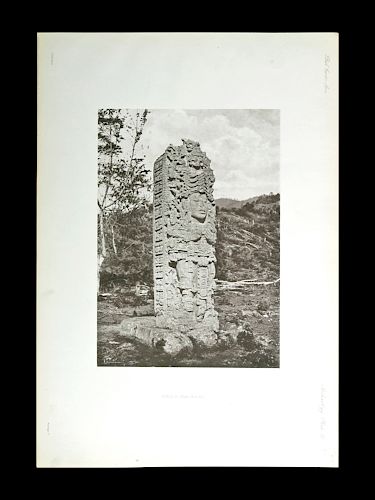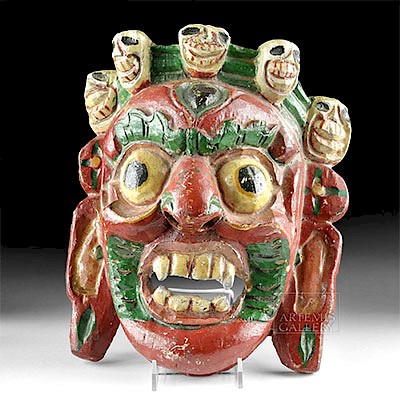Rare Alfred Maudslay 1890 Photogravure Mayan Stela "A"
Lot 25a
About Seller
Artemis Fine Arts
686 S Taylor Ave, Ste 106
Louisville, CO 80027
United States
Selling antiquities, ancient and ethnographic art online since 1993, Artemis Gallery specializes in Classical Antiquities (Egyptian, Greek, Roman, Near Eastern), Asian, Pre-Columbian, African / Tribal / Oceanographic art. Our extensive inventory includes pottery, stone, metal, wood, glass and textil...Read more
Estimate:
$1,400 - $2,100
Absentee vs Live bid
Two ways to bid:
- Leave a max absentee bid and the platform will bid on your behalf up to your maximum bid during the live auction.
- Bid live during the auction and your bids will be submitted real-time to the auctioneer.
Bid Increments
| Price | Bid Increment |
|---|---|
| $0 | $25 |
| $300 | $50 |
| $1,000 | $100 |
| $2,000 | $250 |
| $5,000 | $500 |
| $10,000 | $1,000 |
| $20,000 | $2,500 |
| $50,000 | $5,000 |
| $100,000 | $10,000 |
| $200,000 | $20,000 |
About Auction
By Artemis Fine Arts
Apr 25, 2019
Set Reminder
2019-04-25 10:00:00
2019-04-25 10:00:00
America/New_York
Bidsquare
Bidsquare : Pre-Columbian | Tribal | Ethnographic
https://www.bidsquare.com/auctions/artemis-gallery/pre-columbian-tribal-ethnographic-4035
Featuring ancient and ethnographic art from around the world, including Pre-Columbian, Native American, African / Tribal, Ethnographic, Spanish Colonial, Fossils, Fine Art, much more. Artemis Fine Arts info@artemisgallery.com
Featuring ancient and ethnographic art from around the world, including Pre-Columbian, Native American, African / Tribal, Ethnographic, Spanish Colonial, Fossils, Fine Art, much more. Artemis Fine Arts info@artemisgallery.com
- Lot Description
Alfred Percival Maudslay (British, 1850-1931), photogravure of Mayan Stela A, ca. 1890 CE. A wonderful photogravure of Mayan Stela A in Copan published between 1889 and 1902 in the "Biologia Centrali-Americana, Flora y Fauna", one of the first publications that provided a significant body of Maya inscriptions that continues to remain an invaluable source. Maudslay was a British colonial diplomat, archaeologist, and explorer who was among the first archaeologists to study Mayan civilization. He began his career working for the colonial service in Queensland, Trinidad, Tonga, Fiji, and Samoa; however parted ways with the colonial service in 1880 to travel to Guatemala where he explored Mayan ruins at Copan and Quirigua with archaeologist Frank Sarg. The pair then travelled to Tikal. Maudsley was also the first European scholar to describe Yaxchitlan, and he became famous for his explorations of Chichen with Teoberto Maler. Size: image measures 11.625" L x 7.625" W (29.5 cm x 19.4 cm); sheet measures 19.5" L x 12.625" W
Inspired by the travel accounts of Stephens and Catherwood, Alfred P. Maudslay carried out eight expeditions to the Maya area between 1881 and 1894. His more detailed work deals with six sites: Copán, Quirigua, Yaxchilán, Chichen Itza and Palenque. He photographed the monuments and their inscriptions, and made moulds with plaster and paper. The paper and plaster moulds made during his expeditions, at great cost, were sent to England. Maudslay donated his collection to the Victoria and Albert Museum on condition that casts would be made by his assistant Giuntini at the Museum’s expense. The casts were made between 1886 and 1891 and were later transferred to The British Museum. The Maudslay Collection, now in the Department of Ethnography, consists of over 400 plaster casts, paper and plaster moulds, glass negatives and journals written during his expeditions. It also includes nine stone sculptures from Copán and eight lintels from Yaxchilán. The results of his research, including drawings by Annie Hunter, photographs, site plans and descriptions, were published between 1889 and 1902 in the Biologia Centrali-Americana, Flora y Fauna. These publications formed the first significant corpus of Maya inscriptions and remain an invaluable tool to modern epigraphers.
Elizabeth A. Newsome provides an informative discussion of the iconography on this stela, "The tall crown of woven matting that 18-Rabbit wears belongs to an ancient iconographic complex that can be first identified on Abaj Takalik Stela 2. This Late Preclassic sculpture is one of many in Maya art that show the spirit of a deified ancestor appearing to his descendant. The floating ancestor wears this same woven crown, and his cheek is marked with k'in to identify him as the sun. Schele and Miller (1986:50) remark that this aspect of the sun god, who has squint eyes and a k'in infix in his cheek, seems to represent the daytime sun. Stela 2, then, portrays the soul of a dead king at the zenith of the sky, speaking to his descendant from the shimmering solar disk. His figure emerges from the swirling scrollwork of clouds and clasps a vision serpent in crab-claw position. The serpent, in turn, disgorges some object of power from its jaws." (Elizabeth A. Newsome, Trees of Paradise and Pillars of the World: The Serial Stela Cycle of 18-Rabbit-God K, King of Copan, p. 134)
Provenance: private Santa Fe, New Mexico , USA collection
All items legal to buy/sell under U.S. Statute covering cultural patrimony Code 2600, CHAPTER 14, and are guaranteed to be as described or your money back.
A Certificate of Authenticity will accompany all winning bids.
We ship worldwide and handle all shipping in-house for your convenience.
#124787Old pencil notations on lower right corner. Margins shows minor discoloration commensurate with age.Condition
- Shipping Info
-
All shipping is handled in-house for your convenience. Your invoice from Artemis Gallery will include shipping calculation instructions. If in doubt, please inquire BEFORE bidding for estimated shipping costs for individual items.
-
- Buyer's Premium



 EUR
EUR CAD
CAD AUD
AUD GBP
GBP MXN
MXN HKD
HKD CNY
CNY MYR
MYR SEK
SEK SGD
SGD CHF
CHF THB
THB


















